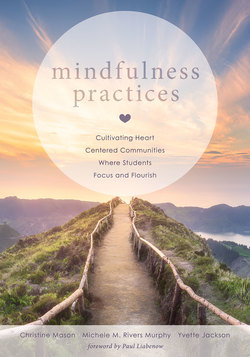Читать книгу Mindfulness Practices - Christine Mason - Страница 9
На сайте Литреса книга снята с продажи.
ОглавлениеForeword
by Paul Liabenow
Whether trauma stems from violence on the streets of high-crime cities like Detroit, New York, or Washington, D.C., or abuse within a child’s own home, the impact on our students is significant. Trauma takes many forms, dramatic and subtle—the death of a grandparent, the loss of a pet, bullying at school, or the ongoing stress of living in poverty. It is pervasive. It is also more and more apparent to teachers that so many of our students exhibit signs of distress and trauma that impede learning, resulting in underachievement, loss of self-esteem, and arrested social-emotional development. Many educators are also suffering from chronic stress, pressure to raise student achievement, high expectations to turn around low-performing schools, and burnout. Trauma and toxic stress compromise students, teachers, and school leaders’ health and well-being.
Trauma takes a toll on learning, instructing, and living. Christine Mason, distinguished elementary and secondary principals, and I executed focus groups, surveys, and discussions in which educators around the United States expressed a sense of helplessness and frustration trying to find antidotes to address the tragic reality of their students’ challenges as well as their own. Teachers and school leaders recognize that traditional instruction is not adequate and that simply having high expectations and more test prep won’t meet student needs, increase achievement, raise staff morale, or improve teacher performance.
Fortunately, there is an exciting knowledge base on the neuroscience of learning, evidence from MRIs, and the authors’ empirical research illustrating how mindfulness practices and compassion can diminish stress and fortify focus, reflection, and higher-order cognitive functioning for both students and educators to mitigate the trauma of adverse childhood experiences’ deleterious impact. Research on the brain’s propensity shows that children are born with the innate potential for high levels of learning and achievement, and teachers are well positioned to help our children reclaim this potential. Human brains contain trillions of pathways, and from birth to age three neural connections continue to be generated at a rate of seven hundred connections per second (Shonkoff & Phillips, 2000; Roberts, 2017; Schiller, 2010). Early childhood educators can help children reclaim this potential using the strategies the authors reference (Bierman & Torres, 2016). Authors Christine Mason, Michele M. Rivers Murphy, and Yvette Jackson incorporated this research to provide us with Mindfulness Practices: Cultivating Heart Centered Communities Where Students Focus and Flourish, a practical guide for teachers and school leaders to effectively address the impact of trauma on social-emotional development, learning, and achievement.
Mindfulness Practices does not present yet another program to follow. It is not an add-on or one more thing to squeeze into our busy days. Rather, the authors advocate for and illustrate change in methods of both being and doing. They provide staff with advice, practices, and exercises to incorporate directly into their teaching, as well as support for activating the benefits of mindfulness for their students—and themselves. Teachers who participated in the Center for Educational Improvement’s (CEI’s) heart centered mindfulness pilot programs in 2017 report that as the foundational practice for cultivating compassionate school environments, mindfulness was a great stress reliever for them, as classroom climates became more positive, with a new calm and sense of renewed enthusiasm and purpose. This new way of being is a new beginning toward directly combating stress, leading to greater compassion, happiness, and success for teachers, administrators, staff, and students. Whether a physical education teacher, health educator, art teacher, special education teacher, school counselor, traditional classroom teacher, or school leader, this book has practical and natural lifelong strategies for you.
As important as spreading love and goodwill is, Mindfulness Practices also does much more. It provides a systematic approach to building persistence, grit, and resilience. In How Children Succeed: Grit, Curiosity, and the Hidden Power of Character, author Paul Tough (2012) says:
What matters most in a child’s development, they say, is not how much information we can stuff into her brain in the first few years. What matters, instead, is whether we are able to help her develop a very different set of qualities, a list that includes persistence, self-control, curiosity, conscientiousness, grit and self-confidence. (p. xv)
As a K–12 educator for thirty-two years, a former superintendent of schools, and the executive director of the Michigan Elementary and Middle School Principals Association, I have worked with thousands of principals and understand their needs as instructional leaders. Mindfulness Practices is a must-read. My prediction is that mindfulness and heart centeredness are not simply trending practices, but that they will be around for decades to come. These practices take pressure off students and teachers, advance well-being, and set the stage for increasing academic achievement.
With the Every Student Succeeds Act (2015), the pendulum is swinging back to a more holistic, whole-child approach to education. This will be a challenge for many as we combat the barriers of bureaucracy, time, and habits. It will take some intentional effort to add creativity and kindness back into our curriculum. Mindfulness Practices will help guide you on your way, with insights, stories, research, and practical exercises. George Leonard and Michael Murphy (1995), founding figures in the human potential movement, say, “To begin any strong practice is to turn the pages of your life to a new chapter” (p. 39). As you turn the pages of this book, will you invest the time and effort to break through for a transformational change? If you are ready and willing to undertake this challenge, this is the book for you.
